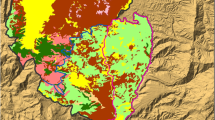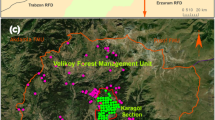Abstract
We compared the dead wood (DW) conditions of Cheshmeh-sar forest and Sardab forest with different management history, including reserve forest and harvested forest. The First forest took 100% inventory from all the available DW. Also dead trees were compared in terms of species, shape, location and quality of fracture in both forests. Volumes of dead wood in Cheshmeh-sar and Sardab forests were 207.47 and 142.74 m3, respectively. Due to this significant difference, impact on the management level was determined. In Cheshmeh-sar forest, 42% of dead trees were standing and 58% were fallen type while in Sardab forest 38.6% were standing and 61.4% fallen. But the difference was not statistically significant between them (p = 0.0587). In terms of quality, dead trees of hard, soft and hollow had the highest frequency, respectively. However, 71.5% of DW was seen as hard dead in Cheshmeh-sar forest while hard dead trees in Sardab forests were 54.2%. Soft quality degree of dead trees which formed in Cheshmeh-sar and Sardab forest were calculated as 26.6% and 43.4% respectively. Also 30% of the dead trees of Sardab forest were eradicated while in Cheshmeh-sar this amount was reduced to 12%. Due to this significant difference ((P=0/018), it is concluded that the type of management and human interference are affecting the quality of dead trees and makes us to think the human interferences could effect on the ecosystem of touched forests.
Similar content being viewed by others
References
Ammer U. 1991. Konsequenzen aus den ergebnissen der totholzforschung für die forstliche praxis. Forstwissenschaftliches Centralblatt, 110: 149–157.
Atici E, Colak AH, Rotherham ID. 2008. Coarse dead wood volume of managed oriental beech (Fagus orientalis Lipsky) stands in Turkey. Investigación Agraria:Sistmas y Recursos Forestales, 17(3): 216–227.
Beets PN, Hood IA, Kimberley MO, Oliver GR, Pearce SH, Gardner JF. 2008. Coarse woody debris decay rates for seven indigenous tree species in the central North Island of New Zealand. Forest Ecology and Management, 256(4): 548–557.
Butler R, Schlaepfer R. 2004. Dead wood in managed forests: how much is enough?. Schweizerische Zeitschrift für Forstwesen, 155(2): 31–37.
Chambers CL. 2002 Forest Management and the dead wood Resource in ponderosa Pine forests; Effects on small mammals. In: Laudenslayer, W. F., Shea, P. J., Valentine, B. E., Weatherspoon, P., Lisle T. E. & Pearce S. H. (eds), Ecology and management of dead wood in western forests, Reno, NV. Gen. Tech. Rep. PSW-GTR-181. Albany,. CA: U.S. Department of Agriculture, Forest Service, Pacific Southwest Research Station. pp. 679–693.
Christensen M, Hahn K, Mountford EP, Ódor P, Standovár T, Rozenbergar D, Diaci J, et al. 2005. Dead wood in European beech (Fagus sylvatica) forest reserves. Forest Ecology and Management, 210(1–3): 267–282.
Christensen M, Hahn K, Mountford EP, Wijdeven SMJ, Manning DB, Standovar T, Odor P, et al. 2003. Study on dead wood in European beech forest reserves. Work package 2 in the nat-man project. Available at: http://www.flec.kvl.dk.natman [accessed 04.03.2010].
Csóka G. 2000. Az elpusztult, korhadó fa szerepe az erdei biodiverzitás fenntartásában. [The role of dead wood in maintaining biodiversity of forests]. In: Frank, T. (ed.), Természet — erdö — gazdálkodás. MME és Pro Silva Hungária Egyesu—let, Eger. pp.85–96.
Daneshvar A. 2009. Reduce of dead tree from a virgin forest on the ground of Shast Kollate site indicator. Journal of Science and Technology of Natural Resources 4(2): 22–33.
Debeljak M. 2005. Coarse woody debris in virgin and Managed forest. Ecological Indicators, 6: 733–742.
Elton CS. 1966. Dying and dead wood. In: Elton, C. S. (ed.), The Pattern of Animal Communities. London, UK: Chapman and Hall, pp. 279–305.
Erajaa S, Halme P, Kotiaho JS, Markkanen A, Toivanen T. 2010. The Volume and composition of dead wood on traditional and forest fuel harvested clear-cut. Silva Fennica, 44(2): 203–211.
Fridman J, Walheim M. 2000. Amount, structure and dynamics of dead wood on managed forestland in Sweden. Forest Ecology and Management, 131:23–36.
Gibb H, Ball JP, Johansson T, Atlegrim O, Hjalten J, Danell K. 2005. Effects of management on coarse woody debris volume and composition in boreal forests in northern Sweden. Scandinavian Journal of forest Research, 20: 213–222.
Green P, Peterken GF. 1997. Variation in the amount of dead wood in the woodlands of the Lower Wye Valley, UK in relation to the intensity of management. Forest Ecology and Management, 98: 229–238.
Guby NAB, Dobbertin M. 1996. Quantitative estimates of coarse wooded debris and standing trees in selected Swiss forests. Global Ecology and Biogeography Letters, 5: 327–341.
Habashi H.1997 Investigation of importance of dead wood in Mazandaran, Vaz forest. In: natural resources factuly Tehran: University, Tehran, Iran
Harmon ME, Franklin JF, Swanson FJ, Sollins P, Gregory SV, Lattin JD, Anderson NH, et al. 1986. Ecology of coarse woody debris in temperate ecosystems. Adv Ecol Res, 15: 133–302.
Harvey AE, Larsen MJ, Jorgensen MF. 1981. Forest management implications of improved residue utilization: biological implications in forest ecosystems. in: Harvesting and Utilization Opportunities for Forest Residues in the Northern Rocky Mountains, Ogden, Utah. USDA Forest Service Intermountain Forest and Range Experimental Station, GTR-INT-110, 259–269.
Keenan RJ, Prescott CE, Kimmins JP. 1993. Mass and nutrient content of woody debris and forest floor in western red cedar and western hemlock forests on northern Vancouver Island. Canadian Journal of Forestry Research, 23: 1052–1059.
Kirby KJ, Reid CM, Thomas RC, Goldsmith FB. 1998. Preliminary estimates of fallen dead wood and standing dead trees in managed and unmanaged forests in Britain. Journal of applied Ecology, 35: 148–155.
Kruys N, Jonsson BG. 1999. Fine woody debris important for species richness on log in managed boreal spruce forest of northern Sweden. Can J For Res, 29: 1295–1299.
Lombardi F, Lasserre B, Tognett R, Marchetti M. 2008. Dead wood in relation to stand management and forest type in central Apennines (Molise, Italy). Ecosystems, 11: 882–894.
Maser C, Trappe JM. 1984. The seen and unseen world of the fallen tree. Gen. Tech. Re PNW-164., Portland.
Motta R. 2006. Coarse woody debris, forest structure and regeneration in the valbona forest reserve paneveggio, Italian Alps. Forest Ecology and Management, 235: 155–163.
Oakland B. 1994. Mycetophilidae (Diptera), an insect group vulnerable to forestry practices? A comparison of clearcut, managed, managed and semi-managed spruce forests in southern Norway. Biodiversity and Conservation, 3: 68–85.
Odor P, Standovár T. 2001. Richness of bryophyte vegetation in a near-natural and managed beech stands: the effects of managementinduced differences in dead wood. Ecological bulletins, 49: 219–229.
Pedlar JH, Pearce JL, Venier LA, Mckenney DW. 2002. Coarse woody debris in relation to disturbance and forest type in boreal Canada. Forest Ecology and Management, 158: 189–194.
Sefidi K. 2006 Investigation of quality and quantity of dead wood in managed forest. In: natural resources faculty Tehran: Tehran University, p.120.
Siitonen J. 2001. Forest management, oarse woody debris and saproxylic organisms. Fennoscandian boreal forest as an example. Ecological Bulletins, 49: 11–41.
Siitonen J, Martikainen P, Punttila P, Rauh J. 2000. Coarse woody debris and stand characteristics in mature managed and old-growth boreal mesic forests in southern Finland. Forest Ecology and Management, 128: 211–225.
Siitonen J, Penttila R, Kotiranta H. 2001. Coarse woody debris, polyporous fungi and saproxylic insects in an old-growth spruce forest in Vodlozero National Park, Russian Karelia. Ecological Bulletins, 49: 231–242.
Taheri-Abkenar K. 2005. Influence of light condition on quality and quantity characteristics of beech (Fagus orientalis) sapling in North of Iran. Asian Journal of Plant Science, 4: 261–263.
Vanderwel MC, Malcolm JR, Mills SC. 2007. A meta-analysis of bird responses to uniform partial harvesting across north america. Conserv Biol, 21(5): 1230–1240.
Zolfaghari E. 2004. Investigation of ecological and silvicultural of dead wood in Iran northern beech forest. Tehran: University of Tehran.
Author information
Authors and Affiliations
Corresponding author
Rights and permissions
About this article
Cite this article
Abkenari, K.T., Akbari, F. & Pilehvar, B. Effect of intervention and type of forest management on quality and quantity characteristics of dead wood in managed and reserve forests: A case study. Journal of Forestry Research 23, 413–418 (2012). https://doi.org/10.1007/s11676-012-0278-9
Received:
Accepted:
Published:
Issue Date:
DOI: https://doi.org/10.1007/s11676-012-0278-9




